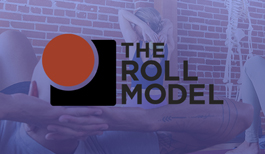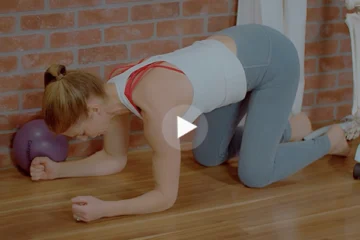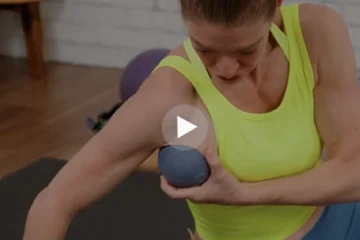
Physical therapist Stephanie Spencer says “You know your multifidus group is working well if you can articulate every vertebrae of your spine and have a well connected core while moving.” And the more control you gain, the greater your potential for range of motion. But this can also be a problem. “If one of the multifidi muscles are not participating in movement, then that level of the spine is held victim to movement from above and below the area.” Thus, that part of the back can become stiff or suffer the consequences of being pushed and pulled without support.
Getting back to the corset analogy again. If the vertebral arches are kind of like the grommets of your corset, what is its “belly?” With a corset, fabric is being pulled back and tighter. Here, the “fabric” is your deepest abdominal muscle, the transversus abdominus.
Check this out from the Nicholas Institute of Sports Medicine and Athletic Trauma website:

Certain muscles of the back that stabilize the spine are reflexively inhibited (shutdown) after injury [and] do not spontaneously recover even if patients are pain free with a return to normal activity levels….These muscles include the lumbar multifidi and the transversus abdominus….the deepest abdominal muscle. [Together the two] function…to form a deep internal corset that acts to stabilize the spine during movement.
Again, from Ann Archer’s excellent article, I learned that researchers in a 2009 study at UC San Diego discovered that:
The sarcomere, or the area where muscle contraction happens, is much smaller [on the multifidus] than in other muscles. But when the multifidus is put on a stretch, as when you bend forward, it actually gets stronger. This is unlike most muscles which, when lengthened, lose their strength. Something different is at work in this muscle!
According to Richard Lieber, PhD, a lead author in the 2009 study, “Our research shows that [the multifidus] is actually the strongest muscle in the back because of its unique design.”
So these pudgy little finger muscles, buried deep in your back, are oh-so-awesome. Sit up now and say thank you! Or better yet, go get your Yoga Tune Up® on and strengthen your miraculous multifidi with some of our exercises.
Read part 1 of this article.
Learn about our Therapy Ball programs for back pain.
Learn about Yoga Tune Up at home.
REFERENCES (in order of citation, parts 1 and 2)
Archer, Anne. Website at http://backandneck.about.com/b/2009/01/12/the-multifidus-muscle-key-to-spinal-stabilization.htm. January 12, 2009.
Sportsinjuryclinic.net. http://www.sportsinjuryclinic.net/cybertherapist/muscles/mutifidus.php.
Musculoskeletal Consumer Review. http://mcr.coreconcepts.com.sg/multifidus-smallest-yet-most-powerful-muscle/.
Beil, Andrew R. Trail Guide to the Body: How to locate muscles, bones and more. Third Addition. Boulder. Books of Discovery. 2005.
Medscape.com. http://www.medscape.com/viewarticle/542466_6
Johnson, Jim. The Back Pain Solution. New Harbinger Publications, Inc. Oakland, CA. 2002.
Spencer, Stepanie. Website at http://www.stephanie-spencer.com/category/the-core/page/2/
Nicholas Institute of Sports Medicine and Athletic Trauma. http://www.nismat.org/ptcor/lbp
Archer, Anne. Website at http://backandneck.about.com/b/2009/01/12/the-multifidus-muscle-key-to-spinal-stabilization.htm. January 12, 2009.
Lieber, Richard L. (and others). “Architectural Analysis and Intraoperative Measurements Demonstrate the Unique Design of the Multifidus Muscle for Lumbar Spine Stability.” The Journal of Bone and Joint Surgery (American). 2009;91:176-185. Website at http://www.ejbjs.org.












WOW! I had no idea that when you lengthen this muscle one would actually LOSE strength! I also did not realize their large role in stabilization – I thought that was primarily the job of the trunk muscles and the erector spinae muscles. I am so excited to keep learning more and more about the muscles and how they work intertwined together!
Thanks so much for these posts.
I knew the multifidi were deep to the erectors but I had yet to see them in a picture, nor had I dug as much as you did to learn so much about them.
Thank you for your giving us the fruits of your labor and I will certainly dig deeper about how flexing the spine strengthens the multifidi because that certainly piqued my interest.
Nikola
Thanks for the interesting anatomical explanation and function of the Multifidi! So important and so often neglected in discussion when core work is the topic! An enjoyable read – nice to see the other references all pull this together as well.
[…] Tune Up® Blog « Yoga Therapy For Seniors – Shoulder Circles Save the Day The Multifidi – Your Under Underwear, Part 2 […]
Awesome post!!! WOW! stretching strengthens the deep core postural muscles of the multifidi, I had no idea. I haven’t thought much about the mulifidi muscles. Thank you for the post it is very informative, I love that rolling tune up balls alone the laminae groove can strengthen as well. You have inspired me to learn more about these muscles. Another wonderful nugget to bring into my teaching to context to my students.
Great post(s) on the multifidi! I am also loving the corset analogy – provides a perfect visualization to help feel and describe the synergy between the multifidi and transverse abdominis as they stabilize and support the spine. And stretching and strengthening at once – so whether backbending or forward bending we’ll be strengthening our multifidi! Super! And thanks for citing your info – I’ve gone to and am very happy with the info provided at http://www.sportsinjuryclinic.net and stephanie-spencer.com. As a new Yoga Tune Up® teacher I very much appreciate having multiple resources to refer to.
I love the corset analogy! Jill’s tubular core work makes so much sense to me. You need to cinch in your corset not only includes your rectus abdominals which is usually the focus of gym sit-ups; but also includes the multifidi and transverse abdominus and obliques.
So if the multifidi strengthen when stretched, then rolling our therapy balls down the laminal grooves one vertebrae at a time (or even just laying on them ‘tazed’) would be a great way for folks with limited mobility or strength to start to build up these muscles since the therapy balls act as mini stretchers! What a great deal! A muscle-building massage!
I like the attention you draw to the multifidi in part one, that they are active even before the core. I live in and work with a community of ageing people and I see that these little muscles are key in keeping the balance that we take for granted while young to be tipped into a series of aches and pains as the multifidi weakens over time (due to a lack of care) which often lead to slips and falls which can then lead to bigger problems such as broken bones and surgeries.
Having read The Multifidi..your under underwear part 1, I had to read part 2. I found it fasinating to discover that the multifidi is the only muscle group that gets stronger as it stretches. I now appreciate the purpose of rolling the spine one vertebra at a time – to scan spine and confirm individual control and thus better range of motion.
I fell in love with the multifidi when we first met (officially). Yoga Tune Up® has allowed me to deepen the love affair as I learn more about this amazing set of muscles and what they do and how we can help them work even more efficiently. Your articles, Parts 1 and 2, have brought together some great information from various experts that will be useful for my own understanding and make me a better Yoga teacher. Thank you!
Thank you for this. As a student new to all things anatomy it was interesting for me to learn that muscles generally use their strength when lengthened. It makes perfect sense, but I had never thought of it that way. Also, to ponder that the Multifidus gets stronger as you bend forward to stretch just points to the individuality of function in each muscle of the body. Very interesting stuff!
Vow-what a piece of mind-blowing information.This goes on to show that forward bends are little bit more of use then opening those tight hammies.Anyhow,I have just founded that stabilizing the core can be much more challenging then we normally perceive when we are working out in the gym.
Yoga Tune Up Tubular Core exercise reminds me of this deep supportive underwear and how it fits around my tissues to maintain stability.
Its very interesting to note that this muscle group gets stronger as it is stretched.
Wow, multifidi! Thank you for under underwear 2. A friend of mine had some of those injured (lower back area). Her doctor was prescribing no movement. She was not getting better. I tried to get get to move to wake up her back so life can flow back to her spine and the area. She is finally coming to the conclusion, that whatever she was doing (or not doing) was not working for her. Yey! it is a start. I will pass these two articles to her for inspiration!
Thank you!